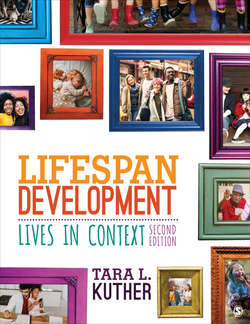Читать книгу Lifespan Development - Tara L. Kuther - Страница 229
Intermodal Perception
ОглавлениеAll stimuli we encounter involve more than one type of sensory information. For example, we see a dog but we also hear its bark. Not only are infants able to sense in multiple modalities, but they are able to coordinate their senses. Intermodal perception is the process of combining information from more than one sensory system (Johnson & Hannon, 2015). Sensitivity to intermodal relations among stimuli is critical to perceptual development and learning—and this sensitivity emerges early in life (Lewkowicz, Leo, & Simion, 2010). That is, infants expect vision, auditory, and tactile information to occur together (Sai, 2005). For example, newborns turn their heads and eyes in the direction of a sound source, suggesting that they intuitively recognize that auditory and visual information co-occur and provide information about spatial location (Newell, 2004).
Newborns show a preference for viewing their mother’s face at 72, 12, and even just 4 hours after birth (Pascalis, Dechonen, Morton, Duruelle, & Grenet, 1995). It was once believed that infants’ preference for their mother’s face was innate. Are infants born knowing their mother’s face? In one study, neonates were able to visually recognize their mother’s face only if the face was paired with their mother’s voice at least once after birth (Sai, 2005). Thus, intermodal perception is evident at birth because neonates can coordinate auditory (voice) and visual stimuli (face) to recognize their mother. They quickly remember the association and demonstrate a preference for her face even when it is not paired with her voice.
Infants integrate touch and vision very early in life. In one classic study, 1-month-old infants were presented with a smooth-surfaced pacifier or one with nubs on it (see Figure 4.12). After exploring it with their mouths, the infants were shown two pacifiers—one smooth and one nubbed. The infants preferred to look at the shape they had sucked, suggesting that they could match tactile and visual stimuli (Meltzoff & Borton, 1979). In another example, 8- to 31-day-old infants fitted with special goggles were presented with a virtual object created by a shadow caster (Bower, Broughton, & Moore, 1970). The virtual object was an illusory object that could be seen by the infant but not touched. When the infant reached for the object, his or her hand felt nothing and flailed through the air. Infants exposed to the virtual object attempted to reach for it and became distressed when they did not feel it, suggesting that vision and touch are integrated and infants expect to feel objects that they can see and reach. Although young infants show impressive capacities to integrate visual and tactile information, these senses are not completely integrated at birth. Newborns can visually recognize an object previously held but not seen, but they cannot tactually recognize an object previously seen and not held, suggesting that intermodal relations among senses are not bidirectional at birth (Sann & Streri, 2007).
We have seen that individuals are embedded in and interact dynamically with their context. James and Eleanor Gibson studied perceptual development from an ecological perspective, emphasizing that perception arises through interactions with the environment (Adolph & Kretch, 2015). Rather than collecting small pieces of sensory information and building a representation of the world, the Gibsons argued that the environment itself provides all the information needed and we perceive the environment directly, without constructing or manipulating sensory information.
Figure 4.12 Nubbed vs. Smooth Pacifier Used to Study Intermodal Perception
Source: Meltzoff and Borton, 1979.
Perception arises from action. Infants actively explore their environment with their eyes, moving their heads and, later, reaching their hands and, eventually, crawling. Perception provides the information infants need to traverse their environment. Through their exploration, infants perceive affordances—the nature, opportunities, and limits of objects (E. J. Gibson & Pick, 2000). The features of objects tell infants about their affordances, including their possibilities for action, such as whether an object is squeezable, mouthable, catchable, or reachable. Infants explore their environment, not randomly but rather systematically searching to discover the properties of the things around them (Savelsbergh, van der Kamp, & van Wermeskerken, 2013). From this perspective, perception arises from action, just as it influences action (J. Gibson, 1979). Exploration and discovery of affordances depends on infants’ capacities for action, which is influenced by their development, genetics, and motivation. For example, a large pot might offer a 10-year-old the possibility of cooking because the child has developed this capacity and can perceive this affordance of the pot. An 18-month-old infant may perceive very different affordances from the pot based on her capacities, such as a drum to bang or a bucket to fill. We naturally perceive affordances, such as knowing when a surface is safe for walking, by sensing information from the environment and coordinating it with our body sensations, such as our sense of balance (Kretch, Franchak, & Adolph, 2014). In this way, our perception of affordances, the opportunities for exploration, influences how we move and interact within our environments (Adolph & Kretch, 2015).
Newborns have remarkable capacities for sensing and perceiving stimuli. Their senses, although well developed at birth, improve rapidly over the first year of life. Moreover, capacities for intermodal perception mean that infants can combine information from various sensory modalities to construct a sophisticated and accurate picture of the world around them.
